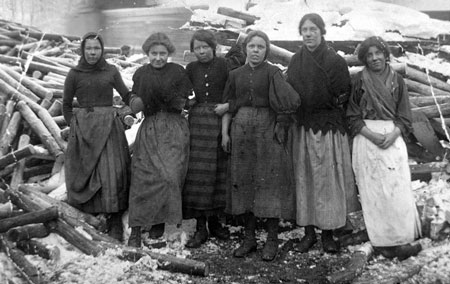A story of how our the Forth and Clyde Canal survived near-bankruptcy and modernised transport, and how it will thrive for years to come, thanks to its modern features.
How it All Began
The Forth and Clyde Canal began in 1763, when engineer John Smeaton surveyed the route for its development (Canals 2001). In 1768, work started on building Scotland’s first canal. It was, at that time, the largest engineering project in Scotland (History of the Canal). The canal was first officially recognized by parliament in 1768, when an act of Parliament was released which allowed the work to begin. This was:
“An Act for making and maintaining a navigable Cut or Canal from the Firth or River of Forth, at or near the Mouth of the River of Carron, in the County of Stirling, to the Firth or River of Clyde, at or near a Place called Dalmuir Burnfoot, in the County of Dumbarton; and also a collateral Cut from the same to the City of Glasgow; and for making a navigable Cut or Canal of Communication from the Port and Harbour of Borrowstounness, to join the said Canal at or near the Place where it will fall into the Firth of Forth.” (Priestly 1831)
The canal moved along what is considered the narrowest part of the lowlands but stopped short of Glasgow due to a lack of funds. However, in 1777, the city merchants raised the funds to complete the canal, in 1785, the government offered aid from Jacobite estates, and in 1790 the canal was able to open (Canals 2021).
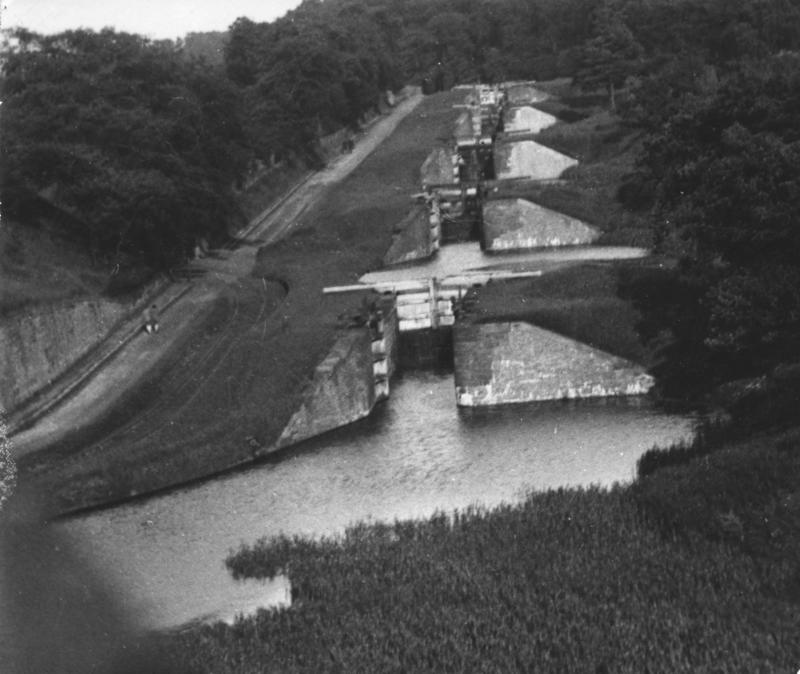

Changing Hands
The canal was soon knocked off its podium by the development of the railway. The management and maintenance of the canal was given to the Caledonian Railway Company after being sold in 1867, 104 years after it began (Canals 2021). The canal changed hands again in 1923 when Caledonian Railway Company was absorbed into London Midland and Scottish Railway (Canals 2021). In 1948, the canal was nationalized and became the property of the British Transport Commission, but then was transferred to the British Waterway board in 1962. The canal’s time ended with its closure a year later. However, as the story goes, the Scottish people were too stubborn to let go of what was once called the Great Canal. With help from the National Lottery, the Millennium Project bought as much of the canal back as possible, with a modern spin on things. In 2001 the canal was reopened and one year later the Queen opened the Falkirk Wheel. In 2014 the Kelpies opened and the canal was complete.
Long ago, the Forth and Clyde Canal was connected to the Union Canal through a series of eleven locks (pictured above). However, with commercial traffic on the Union canal ceasing, the decision was made to cut the link between the two canals in 1933, with the removal and redevelopment of the lock system. Both canals closed, 30 and 32 years later, respectively. The canals were separated, but as part of the Millennium Project the canals were not just to be reborn, they were reconnected like they used to be, just not using an eleven-lock system that took a day to pass through!
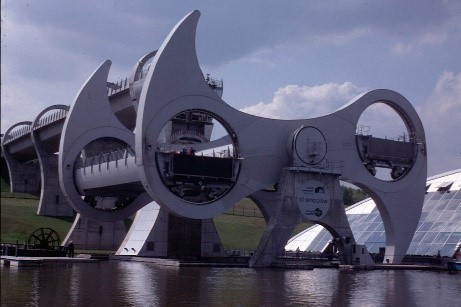

The Falkirk Wheel
The idea was to build the world’s first and only rotating boat lift that is said to be inspired by the local area and culture. The idea board was established in 1994. Many great and bizarre sounding proposals were considered, such as rolling eggs, tilting tanks, a seesaw, and overhead monorails, but the wheel rolled to the finish line and the work began. The inspiration for the wheel’s design has been attributed to many things, whether man-made, like a Celtic spear or a ship’s propellor, or natural, like a whale’s ribcage or a fish’s spine. Either way the Falkirk wheel is one of a kind.
In 1998, work began, and the Falkirk wheel was opened by the Queen on the 24th of May 2002. The wheel is an engineering marvel: it is 35 meters high, and each gondola (the rotating ends) weighs around 600 tons and holds around 500,000 liters of water, but can move with the power 8 household kettles. Now that is a wonder of the engineering world.
The Falkirk wheel uses a complex gear system along with many principles, like that of the Archimedes principle in which, “any body completely or partially submerged in a fluid…at rest is…equal to the weight of the fluid displaced by the body” (2020). These systems and principles combine to allow the wheel to turn both clockwise and anti-clockwise. To find out more about the functioning of the wheel please click here. The Falkirk Wheel now serves as a link between both the Union Canal and the Forth and Clyde Canal. It does not provide a link to the River Forth like the canal originally did – that job belongs to the Queen Elizabeth II Canal which is guarded by not one but two Kelpies.
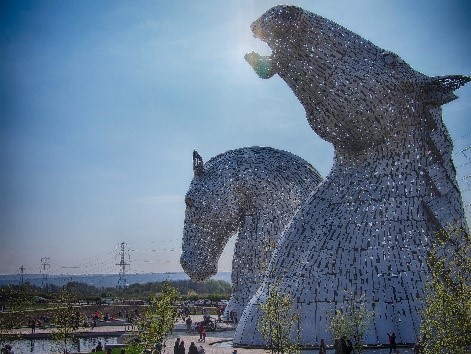

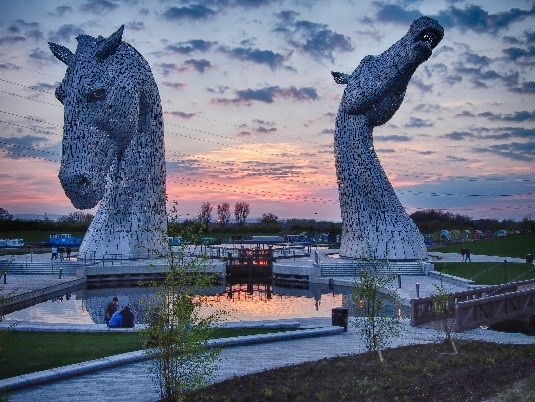

The Kelpies
The Kelpies are the guards of the Queen Elizabeth II Canal and will do anything to protect it, even if that means drawing the world’s attention. The Kelpies are 30-meter-tall sculptures based on the Scottish Myth of water horses and the Clydesdales that worked the canal that these horses watch over. They are the world’s largest equine statues, and that is not all they are… The Kelpies would tower over the Angel of the North and cast shadows over the Moai of Easter Island. They would make the Great Sphinx of Giza look like a house cat and not the big cat that it is. To the Kelpies we are mice, looking up at them, trying not to get trampled.
The Kelpies were designed by Andy Scott, a Scottish sculptor that has completed many works around Scotland, like the Arria in Cumbernauld and the Canter in Edinburgh. The Kelpies are made of steel with a skeleton (that looks a bit like a rollercoaster) and plates that make up the skin of the beasts. (To find out more about their construction click here). The Kelpies statues depict the heads of the horses, portrayed as if from the myth in which they are water horses who can transform into dark or white ponies and trick people onto their backs, take them to the water and eat them (2015). The Kelpies of Falkirk are unlikely to do so, as they are trapped in cement, with only their heads above ground. A drawing by Andy Scott demonstrates how the Kelpies are connected to the myth, showing what we see above ground and the rest of their bodies below ground. It is as though the Kelpies are rising out of the water for their next gallop among us. The kelpies were competed in 2014 and opened to the public that same year. Although they have not been with us long, they are estimated to be here for over 120 years and will be appreciated for generations to come (Canals 2021).
The Forth and Clyde canal started as a way to move goods and ships from east to west and back again, but through the advancement of travel (and the rise of the railway) it became obsolete until the turn of the Millennium. Then it was transformed into something new, with the canal of centuries past being pieced back together and paired with one-of-a-kind monuments that say, “Don’t touch OUR canal again! ‘Cause No ma’er whit you say the Forth and Clyde Canal is here to stay, an’ we’re no letting go!” Without the Falkirk Wheel or the Kelpies the Forth and Clyde canal may have stayed closed forever. May the wheel keep on turning and may the Kelpies keep on guarding it.
By Emily Robertson, Hidden Heritage: Falkirk Travels Through Time volunteer.

